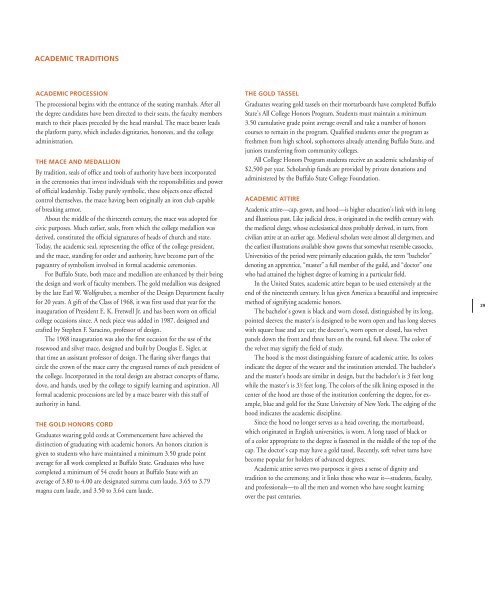2011 COMMENCEMENT - Buffalo State College
2011 COMMENCEMENT - Buffalo State College
2011 COMMENCEMENT - Buffalo State College
Create successful ePaper yourself
Turn your PDF publications into a flip-book with our unique Google optimized e-Paper software.
ACADEMIC TRADITIONS<br />
ACADEMIC PROCESSION<br />
The processional begins with the entrance of the seating marshals. After all<br />
the degree candidates have been directed to their seats, the faculty members<br />
march to their places preceded by the head marshal. The mace bearer leads<br />
the platform party, which includes dignitaries, honorees, and the college<br />
administration.<br />
THE MACE AND MEDALLION<br />
By tradition, seals of office and tools of authority have been incorporated<br />
in the ceremonies that invest individuals with the responsibilities and power<br />
of official leadership. Today purely symbolic, these objects once effected<br />
control themselves, the mace having been originally an iron club capable<br />
of breaking armor.<br />
About the middle of the thirteenth century, the mace was adopted for<br />
civic purposes. Much earlier, seals, from which the college medallion was<br />
derived, constituted the official signatures of heads of church and state.<br />
Today, the academic seal, representing the office of the college president,<br />
and the mace, standing for order and authority, have become part of the<br />
pageantry of symbolism involved in formal academic ceremonies.<br />
For <strong>Buffalo</strong> <strong>State</strong>, both mace and medallion are enhanced by their being<br />
the design and work of faculty members. The gold medallion was designed<br />
by the late Earl W. Wolfgruber, a member of the Design Department faculty<br />
for 20 years. A gift of the Class of 1968, it was first used that year for the<br />
inauguration of President E. K. Fretwell Jr. and has been worn on official<br />
college occasions since. A neck piece was added in 1987, designed and<br />
crafted by Stephen F. Saracino, professor of design.<br />
The 1968 inauguration was also the first occasion for the use of the<br />
rosewood and silver mace, designed and built by Douglas E. Sigler, at<br />
that time an assistant professor of design. The flaring silver flanges that<br />
circle the crown of the mace carry the engraved names of each president of<br />
the college. Incorporated in the total design are abstract concepts of flame,<br />
dove, and hands, used by the college to signify learning and aspiration. All<br />
formal academic processions are led by a mace bearer with this staff of<br />
authority in hand.<br />
THE GOLD HONORS CORD<br />
Graduates wearing gold cords at Commencement have achieved the<br />
distinction of graduating with academic honors. An honors citation is<br />
given to students who have maintained a minimum 3.50 grade point<br />
average for all work completed at <strong>Buffalo</strong> <strong>State</strong>. Graduates who have<br />
completed a minimum of 54 credit hours at <strong>Buffalo</strong> <strong>State</strong> with an<br />
average of 3.80 to 4.00 are designated summa cum laude, 3.65 to 3.79<br />
magna cum laude, and 3.50 to 3.64 cum laude.<br />
THE GOLD TASSEL<br />
Graduates wearing gold tassels on their mortarboards have completed <strong>Buffalo</strong><br />
<strong>State</strong>’s All <strong>College</strong> Honors Program. Students must maintain a minimum<br />
3.50 cumulative grade point average overall and take a number of honors<br />
courses to remain in the program. Qualified students enter the program as<br />
freshmen from high school, sophomores already attending <strong>Buffalo</strong> <strong>State</strong>, and<br />
juniors transferring from community colleges.<br />
All <strong>College</strong> Honors Program students receive an academic scholarship of<br />
$2,500 per year. Scholarship funds are provided by private donations and<br />
administered by the <strong>Buffalo</strong> <strong>State</strong> <strong>College</strong> Foundation.<br />
ACADEMIC ATTIRE<br />
Academic attire—cap, gown, and hood—is higher education’s link with its long<br />
and illustrious past. Like judicial dress, it originated in the twelfth century with<br />
the medieval clergy, whose ecclesiastical dress probably derived, in turn, from<br />
civilian attire at an earlier age. Medieval scholars were almost all clergymen, and<br />
the earliest illustrations available show gowns that somewhat resemble cassocks.<br />
Universities of the period were primarily education guilds, the term “bachelor”<br />
denoting an apprentice, “master” a full member of the guild, and “doctor” one<br />
who had attained the highest degree of learning in a particular field.<br />
In the United <strong>State</strong>s, academic attire began to be used extensively at the<br />
end of the nineteenth century. It has given America a beautiful and impressive<br />
method of signifying academic honors.<br />
The bachelor’s gown is black and worn closed, distinguished by its long,<br />
pointed sleeves; the master’s is designed to be worn open and has long sleeves<br />
with square base and arc cut; the doctor’s, worn open or closed, has velvet<br />
panels down the front and three bars on the round, full sleeve. The color of<br />
the velvet may signify the field of study.<br />
The hood is the most distinguishing feature of academic attire. Its colors<br />
indicate the degree of the wearer and the institution attended. The bachelor’s<br />
and the master’s hoods are similar in design, but the bachelor’s is 3 feet long<br />
while the master’s is 31 ⁄2 feet long. The colors of the silk lining exposed in the<br />
center of the hood are those of the institution conferring the degree, for example,<br />
blue and gold for the <strong>State</strong> University of New York. The edging of the<br />
hood indicates the academic discipline.<br />
Since the hood no longer serves as a head covering, the mortarboard,<br />
which originated in English universities, is worn. A long tassel of black or<br />
of a color appropriate to the degree is fastened in the middle of the top of the<br />
cap. The doctor’s cap may have a gold tassel. Recently, soft velvet tams have<br />
become popular for holders of advanced degrees.<br />
Academic attire serves two purposes: it gives a sense of dignity and<br />
tradition to the ceremony, and it links those who wear it—students, faculty,<br />
and professionals—to all the men and women who have sought learning<br />
over the past centuries.<br />
29












